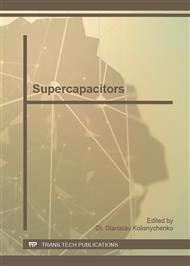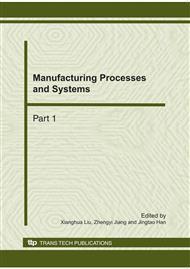p.1400
p.1404
p.1408
p.1413
p.1417
p.1421
p.1427
p.1431
p.1436
Effect of Ultrasonic Disperse on the Properties of Carbon Nanotubes Supercapacitors
Abstract:
Carbon nanotubes (CNTs) of different diameter were synthesized by chemical vapor deposition using LaNi5 alloy of micrometer magnitude as catalyst. High-power ultrasonic grinder was employed to disperse CNTs for various time. CNTs with different dispersion levels were obtained and their impacts on the performance of CNTs supercapacitor electrode were researched as well. Constant current charge-discharge, Cycle Votammetry was employed to study the supercapacitors properties of carbon nanotubes. And the results showed that the specific capacitance of CNTs electrode without ultrasonic was 95.88F/g. However CNTs electrode has preferable electrochemistry properties with 16 hours ultrasonic dispersion, CNTs diameter about 30-50nm and well dispersibility: the specific capacitance had enhanced 69.9%, as high as 162.88F/g.
Info:
Periodical:
Pages:
1417-1420
Citation:
Online since:
October 2010
Authors:
Price:
Сopyright:
© 2011 Trans Tech Publications Ltd. All Rights Reserved
Share:
Citation:



